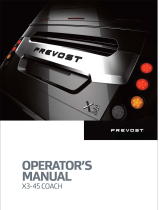
TABLE OF CONTENTS
ii
RADIO .........................................................40
HVAC CONTROL UNIT...............................40
AIR REGISTERS.........................................42
CLUSTER ..................................................42
MESSAGE CENTER DISPLAY (MCD)........42
GAUGES .....................................................42
VEHICLE CLEARANCE INFORMATION.....44
TELLTALE PANEL.......................................44
STEERING COLUMN CONTROLS...........48
MULTI-FUNCTION LEVER..........................48
ELECTRIC HORN........................................48
AIR HORN...................................................49
FOOT-OPERATED CONTROLS...............49
BRAKE PEDAL............................................49
ACCELERATOR PEDAL.............................49
STEERING WHEEL ADJUSTMENT UNLOCK
AIR VALVE..................................................49
ALLISON TRANSMISSION .......................50
OPERATION ...............................................50
RANGE SELECTION-PUSH BUTTON
SHIFTER .....................................................50
FUNCTIONS OF THE "MODE" BUTTON....50
TRANSMISSION OUTPUT RETARDER...52
OPERATING THE RETARDER USING
THE HAND LEVER......................................52
OPERATING THE RETARDER USING
THE BRAKE PEDAL....................................52
OTHER FEATURES........................................53
DETROIT DIESEL ELECTRONIC
CONTROL (DDEC) SYSTEM....................53
DEC IV ELECTRONIC CONTROL
MODULE (ECM)........................................54
MESSAGE CENTER DISPLAY(MCD) ......54
GAUGE MODE............................................55
FUEL ECONOMY MODE ............................55
CLOCK / DIST. MODE.................................55
SET UP MODE............................................56
DIAGNOSTIC MODE...................................58
DATA LOG MODE.......................................60
PASSWORDS .............................................61
PRODRIVERTM ................................................................ 61
ALLISON TRANSMISSION ELECTRONIC
CONTROL UNIT (ECU).............................62
TRANSMISSION RETARDER...................62
JACOBS ENGINE BRAKE.........................62
ANTILOCK BRAKING SYSTEM................63
KNEELING SYSTEM.................................63
HI-BUOY....................................................63
LOW-BUOY................................................63
RETRACTABLE TAG AXLE......................64
IN-STATION LIGHTING.............................64
COOLANT HEATER..................................64
SWITCHING THE HEATER ON ..................64
SWITCHING THE HEATER OFF ................65
COOLANT HEATER TIMER........................65
WHEELCHAIR LIFT ..................................67
WHEELCHAIR LIFT AND
ACCESS DOORS........................................67
OPERATING THE RICON
WHEELCHAIR LIFT.....................................67
OPERATING THE ST.& ST. LIFT................70
INTERIOR APPOINTMENTS ......................72
STARTING AND STOPPING PROCEDURES75
STARTING THE ENGINE .........................75
STARTING FROM THE DRIVER'S SEAT...75
STARTING FROM THE ENGINE
COMPARTMENT.........................................75
COLD WEATHER STARTING.....................76
JUMP STARTING........................................76
ENGINE BLOCK HEATER........................77
ENGINE WARM-UP ..................................77
TRANSMISSION WARM-UP.....................77
SAFETY FEATURES AND EQUIPMENT.......79
EMERGENCY EXITS................................79
SIDE WINDOWS .........................................79
ROOF HATCH.............................................79
ENTRANCE DOOR .....................................80
EMERGENCY EQUIPMENT.....................80
FIRE EXTINGUISHERS ..............................80
FIRST AID KIT.............................................81
FIRE HATCHET...........................................81
WARNING REFLECTORS ..........................81
JACK AND TOOLS......................................81
SPARE PARTS KIT.....................................81
LIMP-HOME BELT.......................................81
SPARE WHEEL AND TIRE.......................82
CHANGING A WHEEL ................................82
EMERGENCY AIR-FILL VALVES.............83
EMERGENCY AND PARKING BRAKES..84
JACKING POINTS.....................................84
HYDRAULIC JACK......................................84
TOWING....................................................85
DAYTIME RUNNING LIGHTS...................85
FOG LIGHTS.............................................85
COMPARTMENT LIGHTING ....................85
MUD FLAPS AND SPLASH GUARDS......85
BACK UP CAMERA...................................86
BACK UP ALARM......................................86
AUDIBLE ALERTS ....................................86
CARE AND MAINTENANCE..........................89
CLEANING ................................................89
SEAT UPHOLSTERY..................................89
PLASTIC AND VINYL..................................90
WINDOWS...................................................90
STAINLESS STEEL.....................................90

































